Muhammet Sami Yavuz
FARE: A Deep Learning-Based Framework for Radar-based Face Recognition and Out-of-distribution Detection
Jan 14, 2025



Abstract:In this work, we propose a novel pipeline for face recognition and out-of-distribution (OOD) detection using short-range FMCW radar. The proposed system utilizes Range-Doppler and micro Range-Doppler Images. The architecture features a primary path (PP) responsible for the classification of in-distribution (ID) faces, complemented by intermediate paths (IPs) dedicated to OOD detection. The network is trained in two stages: first, the PP is trained using triplet loss to optimize ID face classification. In the second stage, the PP is frozen, and the IPs-comprising simple linear autoencoder networks-are trained specifically for OOD detection. Using our dataset generated with a 60 GHz FMCW radar, our method achieves an ID classification accuracy of 99.30% and an OOD detection AUROC of 96.91%.
FERT: Real-Time Facial Expression Recognition with Short-Range FMCW Radar
Nov 18, 2024
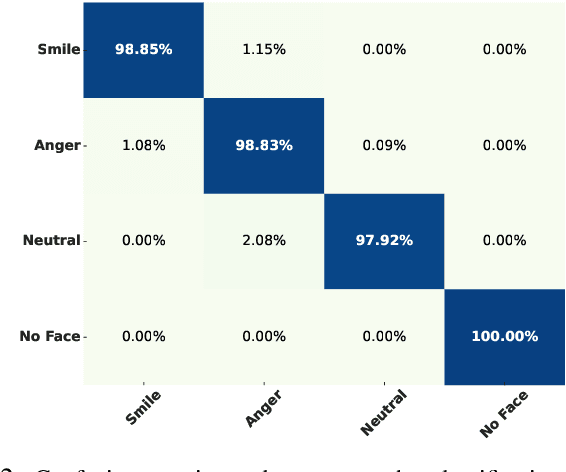
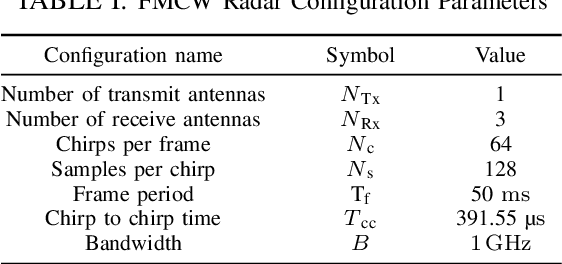

Abstract:This study proposes a novel approach for real-time facial expression recognition utilizing short-range Frequency-Modulated Continuous-Wave (FMCW) radar equipped with one transmit (Tx), and three receive (Rx) antennas. The system leverages four distinct modalities simultaneously: Range-Doppler images (RDIs), micro range-Doppler Images (micro-RDIs), range azimuth images (RAIs), and range elevation images (REIs). Our innovative architecture integrates feature extractor blocks, intermediate feature extractor blocks, and a ResNet block to accurately classify facial expressions into smile, anger, neutral, and no-face classes. Our model achieves an average classification accuracy of 98.91% on the dataset collected using a 60 GHz short-range FMCW radar. The proposed solution operates in real-time in a person-independent manner, which shows the potential use of low-cost FMCW radars for effective facial expression recognition in various applications.
FOOD: Facial Authentication and Out-of-Distribution Detection with Short-Range FMCW Radar
Jun 06, 2024



Abstract:This paper proposes a short-range FMCW radar-based facial authentication and out-of-distribution (OOD) detection framework. Our pipeline jointly estimates the correct classes for the in-distribution (ID) samples and detects the OOD samples to prevent their inaccurate prediction. Our reconstruction-based architecture consists of a main convolutional block with one encoder and multi-decoder configuration, and intermediate linear encoder-decoder parts. Together, these elements form an accurate human face classifier and a robust OOD detector. For our dataset, gathered using a 60 GHz short-range FMCW radar, our network achieves an average classification accuracy of 98.07% in identifying in-distribution human faces. As an OOD detector, it achieves an average Area Under the Receiver Operating Characteristic (AUROC) curve of 98.50% and an average False Positive Rate at 95% True Positive Rate (FPR95) of 6.20%. Also, our extensive experiments show that the proposed approach outperforms previous OOD detectors in terms of common OOD detection metrics.
HAROOD: Human Activity Classification and Out-of-Distribution Detection with Short-Range FMCW Radar
Dec 14, 2023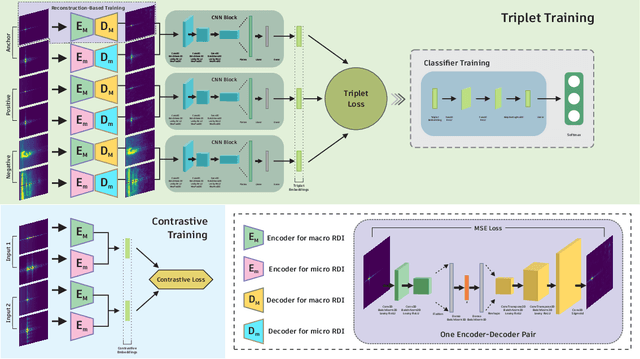

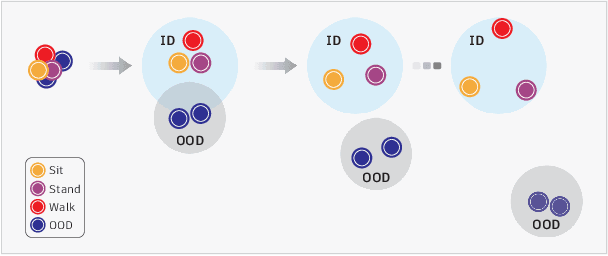
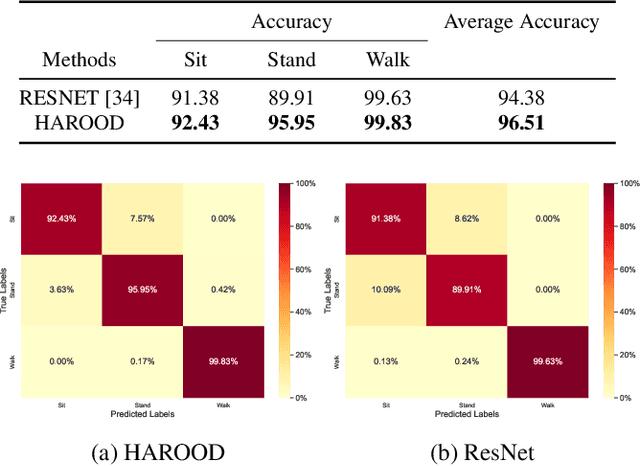
Abstract:We propose HAROOD as a short-range FMCW radar-based human activity classifier and out-of-distribution (OOD) detector. It aims to classify human sitting, standing, and walking activities and to detect any other moving or stationary object as OOD. We introduce a two-stage network. The first stage is trained with a novel loss function that includes intermediate reconstruction loss, intermediate contrastive loss, and triplet loss. The second stage uses the first stage's output as its input and is trained with cross-entropy loss. It creates a simple classifier that performs the activity classification. On our dataset collected by 60 GHz short-range FMCW radar, we achieve an average classification accuracy of 96.51%. Also, we achieve an average AUROC of 95.04% as an OOD detector. Additionally, our extensive evaluations demonstrate the superiority of HAROOD over the state-of-the-art OOD detection methods in terms of standard OOD detection metrics.
HOOD: Real-Time Robust Human Presence and Out-of-Distribution Detection with Low-Cost FMCW Radar
Jul 24, 2023



Abstract:Human presence detection in indoor environments using millimeter-wave frequency-modulated continuous-wave (FMCW) radar is challenging due to the presence of moving and stationary clutters in indoor places. This work proposes "HOOD" as a real-time robust human presence and out-of-distribution (OOD) detection method by exploiting 60 GHz short-range FMCW radar. We approach the presence detection application as an OOD detection problem and solve the two problems simultaneously using a single pipeline. Our solution relies on a reconstruction-based architecture and works with radar macro and micro range-Doppler images (RDIs). HOOD aims to accurately detect the "presence" of humans in the presence or absence of moving and stationary disturbers. Since it is also an OOD detector, it aims to detect moving or stationary clutters as OOD in humans' absence and predicts the current scene's output as "no presence." HOOD is an activity-free approach that performs well in different human scenarios. On our dataset collected with a 60 GHz short-range FMCW Radar, we achieve an average AUROC of 94.36%. Additionally, our extensive evaluations and experiments demonstrate that HOOD outperforms state-of-the-art (SOTA) OOD detection methods in terms of common OOD detection metrics. Our real-time experiments are available at: https://muskahya.github.io/HOOD
MCROOD: Multi-Class Radar Out-Of-Distribution Detection
Mar 10, 2023



Abstract:Out-of-distribution (OOD) detection has recently received special attention due to its critical role in safely deploying modern deep learning (DL) architectures. This work proposes a reconstruction-based multi-class OOD detector that operates on radar range doppler images (RDIs). The detector aims to classify any moving object other than a person sitting, standing, or walking as OOD. We also provide a simple yet effective pre-processing technique to detect minor human body movements like breathing. The simple idea is called respiration detector (RESPD) and eases the OOD detection, especially for human sitting and standing classes. On our dataset collected by 60GHz short-range FMCW Radar, we achieve AUROCs of 97.45%, 92.13%, and 96.58% for sitting, standing, and walking classes, respectively. We perform extensive experiments and show that our method outperforms state-of-the-art (SOTA) OOD detection methods. Also, our pipeline performs 24 times faster than the second-best method and is very suitable for real-time processing.
Reconstruction-based Out-of-Distribution Detection for Short-Range FMCW Radar
Feb 27, 2023



Abstract:Out-of-distribution (OOD) detection recently has drawn attention due to its critical role in the safe deployment of modern neural network architectures in real-world applications. The OOD detectors aim to distinguish samples that lie outside the training distribution in order to avoid the overconfident predictions of machine learning models on OOD data. Existing detectors, which mainly rely on the logit, intermediate feature space, softmax score, or reconstruction loss, manage to produce promising results. However, most of these methods are developed for the image domain. In this study, we propose a novel reconstruction-based OOD detector to operate on the radar domain. Our method exploits an autoencoder (AE) and its latent representation to detect the OOD samples. We propose two scores incorporating the patch-based reconstruction loss and the energy value calculated from the latent representations of each patch. We achieve an AUROC of 90.72% on our dataset collected by using 60 GHz short-range FMCW Radar. The experiments demonstrate that, in terms of AUROC and AUPR, our method outperforms the baseline (AE) and the other state-of-the-art methods. Also, thanks to its model size of 641 kB, our detector is suitable for embedded usage.
 Add to Chrome
Add to Chrome Add to Firefox
Add to Firefox Add to Edge
Add to Edge